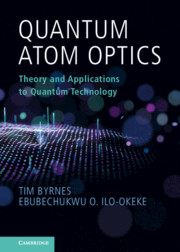Book contents
- Frontmatter
- Dedication
- Contents
- Foreword
- Preface
- 1 Quantum Many-Body Systems
- 2 Bose–Einstein Condensation
- 3 The Order Parameter and Gross–Pitaevskii Equation
- 4 Spin Dynamics of Atoms
- 5 Spinor Bose–Einstein Condensates
- 6 Diffraction of Atoms Using Standing Wave Light
- 7 Atom Interferometry
- 8 Atom Interferometry Beyond the Standard Quantum Limit
- 9 Quantum Simulation
- 10 Entanglement Between Atom Ensembles
- 11 Quantum Information Processing with Atomic Ensembles
- References
- Index
8 - Atom Interferometry Beyond the Standard Quantum Limit
Published online by Cambridge University Press: 23 July 2021
- Frontmatter
- Dedication
- Contents
- Foreword
- Preface
- 1 Quantum Many-Body Systems
- 2 Bose–Einstein Condensation
- 3 The Order Parameter and Gross–Pitaevskii Equation
- 4 Spin Dynamics of Atoms
- 5 Spinor Bose–Einstein Condensates
- 6 Diffraction of Atoms Using Standing Wave Light
- 7 Atom Interferometry
- 8 Atom Interferometry Beyond the Standard Quantum Limit
- 9 Quantum Simulation
- 10 Entanglement Between Atom Ensembles
- 11 Quantum Information Processing with Atomic Ensembles
- References
- Index
Summary
This chapter describes the use of squeezed states to improve the sensitivity in the estimation of the relative phase accumulated in a Bose--Einstein condensate (BEC) beyond the standard quantum limit. We begin by examining the specific example of a two-component BEC, where atoms in two different hyperfine levels interact with each other. By evolving an initial superposition of states under an effective Hamiltonian, a squeezed state is realized. Next, the squeezing is visualized using the Q-function, giving the mean spin direction and shape of the BEC distribution. We discuss the basic operation of Ramsey interferometry, which is a classic example of two-slit atom diffraction. We then calculate the error in estimating the relative phase shift using the error propagation formula that allows us to define the squeezing parameter. This measures the amount of metrological gain using squeezed states over unsqueezed states. We give an example of the metrological gain in the estimation of the relative phase shift using a squeezed state of the two-component BEC as an input state to an atom Mach--Zehnder interferometer. The Fisher information is used to find which rotation axis gives the optimal information from a given initial state. Finally, we parameterize the nonlinear phase per atom responsible for squeezing and discuss how this parameter is controlled in different experiments.
Keywords
- Type
- Chapter
- Information
- Quantum Atom OpticsTheory and Applications to Quantum Technology, pp. 130 - 151Publisher: Cambridge University PressPrint publication year: 2021



